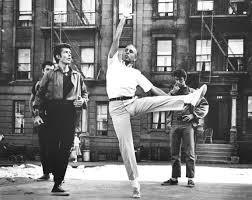COURTNEY O'SULLIVAN
'Aspiring Dancer'
Jerome Robbins-
Research Jerome Robbins and write a short biography of his career. Comment on Jerome Robbins influence in the commercial dance sector.
Jerome Robbins was born on the 11th October 1918 in New York. Jerome Robbins was one of 20th centuries most influential and inspiring choreographers in musical theatre and ballet. He didn’t always want to be a dancer and he started out studying chemistry at New York University before family problems occurred during the great depression. He then found his love for dance and began his career in the dance industry. George Balanchine was the first to cast Robbins in a Broadway show and not long after that he got into Ballet Theatre. Robbins started performing in 1937 only as chorus lines and then joined ballet theatre where he only danced as a background dancer before moving onto choreography. Robbins trained in ballet theatres Russian-influenced repertory and it made him question the repertoire he didn’t understand why he couldn’t dance about something meaningful for example; American subjects or dance about and learn about how dancer’s bodies were dancing at that time and how we are now.
Robbins as a choreographer was different from most choreographers as he freely combined classical ballet with modern dance and jazz techniques to create a whole new way of interpreting dance his creations that led him to earning three Tony awards for High Button Shoes, West Side Story, and Fiddler on the Roof. He then went on to choreograph his own Broadway shows. Fancy Free was his main hit which led him to Broadway in 1954. Robbins first breakthrough was when he composed ‘Fancy Free’ a scenario about social life and general life including social dancing which was around the war years. ‘Fancy Free’ made the audience talk and between them Robbins was portrayed as a “jazz choreographer” having done an impressive jazz ballet his influence on the commercial sector was noticed as his career with impeccable movements between ballet and commercial theatre. Robbins' choreographic style was a blending of ballet, modern, jazz and social dance idioms. At that time many people doubted that ballet could ever be an American art and Robbins made it his goal to collaborate styles together his influences for choreography was mixed with contemporary elements, street style, urban cool and comedy. Robbins took much interest to every detail including sets, costumes, and lighting he also worked closely with designers. Whether Robbins was working on ballet pieces or theatre pieces his natural talent of comedy were inspired throughout them. In the late 1940’s Robbins was always considering combining ballet and commercial theatre together due to the entertainment value and making deeper personal subject matter as he was always seen as that “ballet man” or that “Broadway man” and Robbins liked to push boundaries . Another of Robbins major hits was west side story, west side story is based upon youth culture and immigration and to add tension to the story and make it more natural Robbins insisted the cast members created their own bios and to base upon real life feelings and issues.
Robbins work was successful because as a choreographer he used ballet and jazz technique but created Broadway musicals within them something which was different and exciting to watch back then. He was also successful as he used different elements to create his pieces he would use abstract and profound elements. He was also very inventive and would use theatrical elements such as words and music to make his work interesting, all of these elements were wisely used to make Jerome Robbins work successful with the audience. Jerome Robbins attracted many pioneers of dance and his work became more noticeable and successful that he attracted and inspired pioneers such as Balanchine; he was also noticed by Todd Bolender for his success in the City Ballet. Jerome Robbins was a choreographer who appealed to all ages he toured in the 1950’s and all ages were following his tours, he attracted young age types from his stints and broadways but also the older generation for his creative ballet creations. (thenewyorktimes.1998) No choreographer like Robbins has changed and influenced the American scene and collaborated styles to make ballet theatre more commercialized or been so precise in his excellence of his creative energy. He contributed a huge amount of superb work to our dance culture, represented all over the world, and most famously for his continuous performances of musicals during the last 35 years. (Conrad.2000)
Bibliography:
Christine Conrad (October 2000). jerome robbins that broadway man. London: Booth-Clibborn Editions. Pg20-pg264.
Anna Kisselgoff. (1998). Jerome Robbins, 79, Is Dead; Giant of ballet and broadway. Available: http://www.nytimes.com/1998/07/30/theater/jerome-robbins-79-is-dead-giant-of-ballet-and-broadway.html. Last accessed 29/11/2014.
Photo Credits:
topics.nytimes.com
en.wikipedia.org
en.wikipedia.org



CHECK OUT JEROME ROBBINS WEST SIDE STORY CHOREOGRAPHY!
WEST SIDE STORY- PROLOGUE - OFFICAL FULL NUMBER - 5OTH ANNIVERSARY!
Link to video: https://www.youtube.com/watch?v=bxoC5Oyf_ss